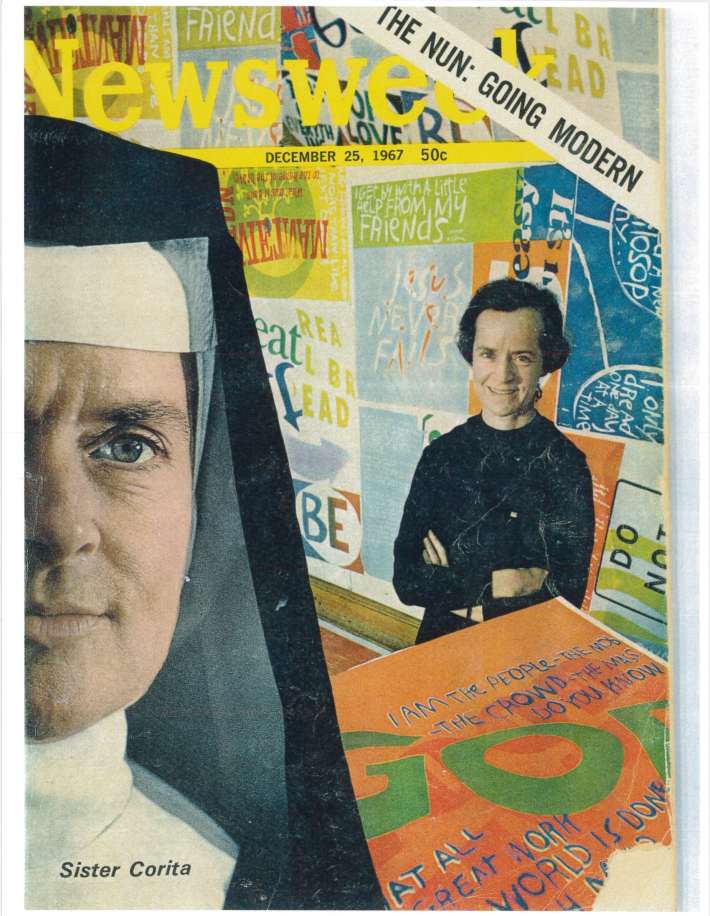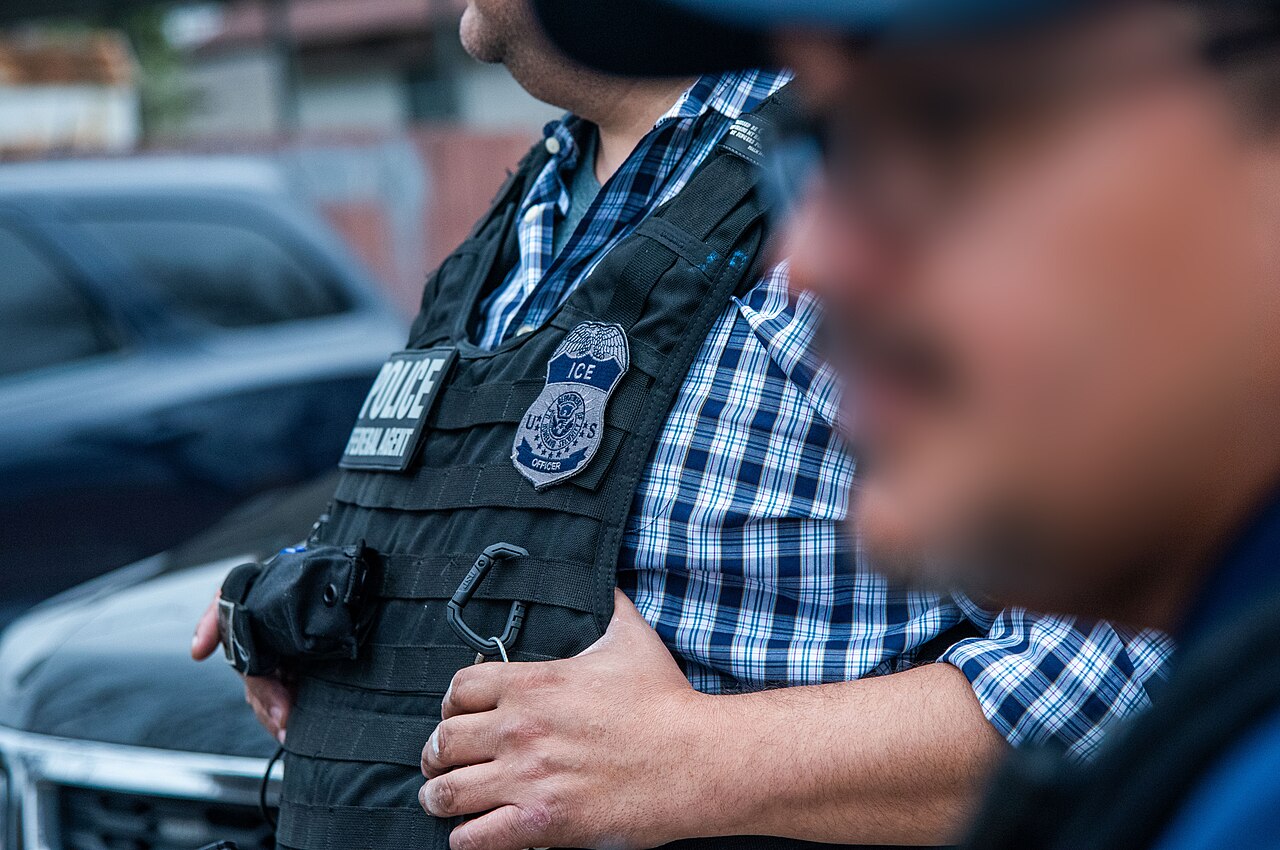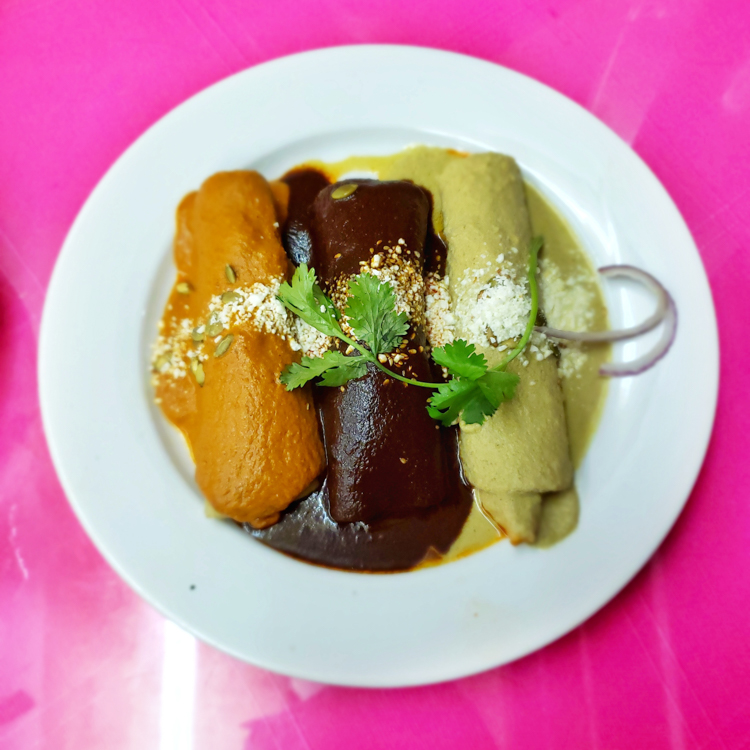should like to be able to love my country as much as I love justice.”
A print bearing this powerful quote by Albert Camus crafted by DIY printmaker Sister Corita Kent in her East Hollywood office hung on the wall of Senator Bobby Kennedy’s office in DC. Sister Corita was an artist, educator, social justice advocate, and perhaps L.A.’s most prolific nun. But now the historic space that incubated her passion for art and education is in jeopardy thanks to developers who want to make way for a new grocery store and parking structure.
While she ran her DIY print house and gallery space at her old studio at 5518 Franklin Avenue, she also was celebrated across the country. She combined elements of popular advertising images and slogans, song lyrics, biblical verses, and literature to form the groundwork for what would become her pop-art movement born in Los Angeles. Her old studio is considered a neighborhood landmark in East Hollywood, but last week the fate of the building was uncertain.

While her name and work might not be familiar right now, she was a pioneer in both the medium of pop art and street art. During the 1960s and 70s, her work attracted the attention of cultural tastemakers like Alfred Hitchcock and Charles and Ray Eames. In 1966, the Los Angeles Times named Corita one of their Women of the Year. She was on the cover of Newsweek in 1967, and Harper’s Bazaar profiled her in “100 American Women of Accomplishment.” It was not uncommon for the casual observer to pass by the Franklin Avenue studio and see Corita’s work along with the work from her students hung outside the building preaching progressive messages and images of love and hope and peace.
“If you don’t have public art that comes from people as opposed to having to go through committees and being approved by politicians, then nobody feels like they have a voice.”
In 1985, she also created Love Stamp, which is perhaps her most recognizable work. The U.S. Postal Service sold more than 700 million of the stamps. In November 2019, the city and county of Los Angeles, to create more awareness and to celebrate her life and work designated the 20th of November as Corita Day in honor of her 101st birthday.
A month ago, a group of developers approached the Hollywood Neighborhood council announcing plans to take over the property that now is home to a Rite Aid and a mom and pop dry cleaning business. They plan to bulldoze and make way for Lazy Acres Market and a parking structure. At the time of the meeting, there was no mention of the history of the building and how it served as Sister Corita’s launchpad during her time of teaching art at Immaculate Heart College across the street.

This building is the space where Sister Corita created and taught her students a visual language that struck a chord with the progressive nature of the decade in the 60s—using a serigraph, which is a type of silkscreen machine to create a body of precursor to the pop-art genre.
On August 10th, the Hollywood United Neighborhood Council reviewed the project again with the presentation from the developers. Having caught wind of the project, Richard Schave and Kim Cooper of Esotouric Secret Los Angeles began posting on their Twitter for fellow preservation enthusiasts to call into the meeting to voice their disdain for the destruction of the former studio site.

According to Cooper and Schave, Bristol Farms, which owns Lazy Acres, and their
Attorney Dale Goldsmith, omitted the space’s historical value when presenting to the Hollywood United Neighborhood Council. A tactic that they say is standard for these types of situations.
As calls from various stakeholders poured in voicing disapproval of the project, the developer’s party offered to put up posters of Corita’s work inside of the market. Not satisfied with the gesture, individual stakeholders said that simply wasn’t good enough. Esotouric provided a timeline and a summary of the situation on their website, which documents L.A.’s culture and historic buildings: If the property is preserved, the approval of the supermarket project itself would be DOA.

Schave and Cooper are quick to point out that the decision-making process should not solely lay with the neighborhood council but also Mitch O'Farrell of CD-13, who oversees the district.
“...this would not be happening if the studio had housed a famous male artist or male luminary. Too often, women’s accomplishments go unprotected, they contend, even someone who won as many awards and recognitions as Corita Kent did.”
“The takeaway is that Council District 13th should put a motion before the (city) council to send this property to the Offices of Historic Resources for a full staff report and reviewed by the Cultural Heritage Commission,” said Schave during our phone call the day after the neighborhood council meeting.
Cooper and Schave also mention to L.A. Taco that Sister Corita’s influences go beyond her art and to her students as well. Case in point Sister Karen Boccalero (May 19, 1933 - June 24, 1997), who studied with Sister Corita at Immaculate Heart and founded Self-Help Graphics in Boyle Heights. “Día de Los Muertos would not exist (in Los Angeles) without Sister Corita,” Schave believes.

Cooper adds, “We’ve lost spaces like this. The Dale Goldsmiths of the world have made it very, very expensive...to have art spaces or community spaces. If you don’t have public art that comes from people as opposed to having to go through committees and being approved by politicians, then nobody feels like they have a voice. I think every kid coming out of Corita’s class knew they could actually change the way that people thought by making a piece of art, and that's revolutionary.”
Speaking with Nellie Scott, a representative from Hollywood's Corita Art Center, said via email: “The building is where Corita during the period from 1960 to 1968 made some of her most recognizable works, hosted notable creative leaders, and influenced a generation of young artists through her art and teaching. The zoning board meeting is slated to take place any day now.”
The Corita Art Center efforts currently include putting together a rapid response application for L.A.’s Cultural Heritage Commission to have the opportunity to review the building that also illustrates the continued importance of art and culture in Los Angeles as a critical driver of our economy, and one that provides essential resources to our communities.
“[Andy Warhol] saw what she was doing...and took that back to New York and built his whole legacy off of that. As often, the true innovators never get recognized, especially female innovators. It takes some man to steal the idea and make the money off of it.”
The structure would qualify under Category 2 of the Cultural Monument Ordinance Monument Designation Criteria as it is associated with the lives of historic personages important to national, state, city, or local history. More notably, structures that were occupied during the "productive" period of a notable figure's life.
Curry points out that this might not be as much of an issue given if Corita was a man, “...this would not be happening if the studio had housed a famous male artist or male luminary. Too often, women’s accomplishments go unprotected, they contend, even someone who won as many awards and recognitions as Corita Kent did.”

It’s important to note that Corita’s legacy and cultural influence is chock-full of historical erasure. Aaron Rose, whose credits include artist, writer, independent curator, and filmmaker, was asked to submit a letter of support to the after hearing about the possible demolition of the site via the Corita Art Center. Rose, who directed a documentary on Corita’s life called “Become Microscope” (2014), curated various shows internationally of her work.
Speaking about her historical significance recounts a story of Andy Warhol’s show at the Ferus Gallery, where he debuted his famous soup cans paintings. Sister Corita, who was in attendance at the show, was already working with serigraphs and silkscreens. “I believe that Andy Warhol stole the idea of silkscreens from Corita,” said Rose. “He saw what she was doing...and took that back to New York and built his whole legacy off of that. As often, the true innovators never get recognized, especially female innovators. It takes some man to steal the idea and make the money off of it.”
While the fate of the building is uncertain, there is a strong sense of hope that by raising attention to the lasting legacy of Sister Corita and her influential body of work will continue to resonate with future generations of Angelenos and beyond as well.
Speaking with April Dammann via email, who authored the unofficial Corita Kent. Art and Soul. The Biography, (Angel City Press, 2015), shares the following about Corita’s legacy.
“Here was a nun, teacher, and extraordinary serigrapher whose work is appreciated much more today, than when she was turning out a mind-numbing amount of artworks in that small studio across the street from then-Immaculate Heart College.
While the fate of the building is uncertain, there is a strong sense of hope that by raising attention to the lasting legacy of Sister Corita and her influential body of work will continue to resonate with future generations of Angelenos and beyond as well.
L.A. Taco has reached out to Mitch O’ Farrell’s office, Dale Goldsmith, Bristol Farms, and the Hollywood United Neighborhood council for comment and will update accordingly.







